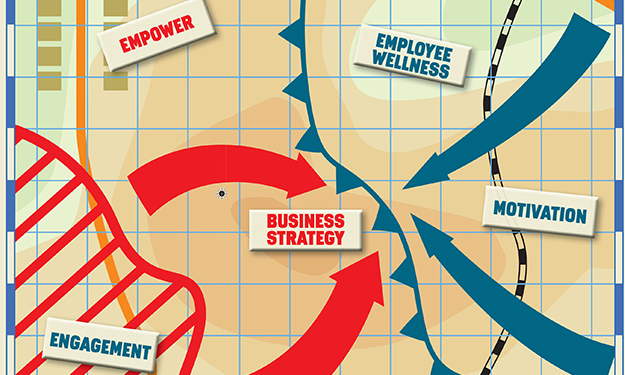The economy may have largely recovered from the global downturn, but conditions remain tough for many businesses, and organisations will need employees to be at their best when they return from the Christmas festivities. For many HR and benefits professionals, motivating staff for the year ahead will be top of their to-do list in the new year.

If you read nothing else, read this…
- Recognition, career progression and flexibility are all highly valued by today’s employees.
- Empowering staff to succeed in their work while retaining a work-life balance is also gaining prominence.
- Some employers are looking to use new pensions rules to motivate and retain staff.
Jackie Waller, principal reward consultant at Aon Hewitt, says the consultancy’s global employee database reveals that career progression is the main motivating factor for today’s employees. “That is what we see coming up across the age groups as the key engagement driver,” she says. “More employers are implementing things like career frameworks, so it is much clearer for employees about where they could go next if they want to remain in the organisation.”
There is also a move to empower staff to take more control of their work and personal lives. Paul Hannam, managing director of performance management firm iPerform, says: “Managers often try to motivate staff using systems, processes, incentives and remuneration, yet research and psychology consistently show that the most powerful motivators are intrinsic: autonomy, fulfilment, purpose and a sense of progress.”
Hannam says employers need to give staff the tools to manage stress better , as well as helping them to achieve a better work-life balance.
Research published in 2014 by Waller, Reuz, Poole and Muir at Ashridge Business School backs this up, finding that when an employee experiences a negative emotion, such as being criticised by a manager, it triggers a fight-or-flight response, which may cause the individual to ’shut down’.
Understand talents and strengths
Sharon Olivier, a leadership development and organisational wellness specialist, says: “Managers need to make a far greater effort to understand the talents and strengths of their staff, and to find ways to make jobs flexible to allow for the expression of talent.”
Toby Burton, reward specialist at recruitment firm Eton Bridge Partners, says employee wellness in general will become more of a focus in 2015, pointing out the strategy’s success in the US. “There is definitely increased awareness of the need to look after the wellbeing of employees , and recognition of the business benefits it can bring,” he says. “This is an area that will continue to grow.”
The focus on staff wellbeing could see more organisations launch charitable or socially beneficial initiatives, says Matthew Gregson, consulting director at Thomsons Online Benefits. “Millennials, in particular, want more than just a place to work,” he says. “They want an employer that inspires and enables them to make a contribution to the local community. Group fundraising initiatives, such as fun runs, hiking expeditions and bake sales, are becoming more popular.”
Where there is a physical activity attached to these initiatives, employers can benefit too by having a healthier and less stressed workforce.
But this is not to say that money is no longer valid as a motivator . According to the Financial stress survey, published by Sodexo Benefits and Rewards Services, 22% of employees say their financial situation causes them stress.
Acknowledge financial strain
Iain McMath, chief executive at the benefits provider, says: “Employers need to acknowledge the financial strain their employees are under, and consider financial wellbeing and support as part of their wider motivation strategies in 2015.”
Here, employers may be able to take advantage of the changes around pensions announced in the 2014 Budget . Derek Miles, managing director of consultancy Aspira, has seen a surge of interest in helping employees understand the implications of the Budget reforms, particularly employees’ ability to access their pensions from the age of 55.
“It could be quite demotivating if staff don’t know where to go or what to do, or indeed if they make poor choices,” he says. “If [employers] can give staff a face-to-face meeting to help them make the right decisions, that would stand them in good stead further down the road.”
Organisations that have to comply with auto-enrolment legislation in 2015 can also use this to their advantage by making employer contributions higher than the minimum amount, says Morten Nilsson, chief executive of Now: Pensions. About 17% of employers intend to do this initially and a further 9% plan to do so further down the line, he adds.
Regular appreciation and praise
Recognition is another motivational strategy that is in vogue. One4all Rewards’ research The power of thank you , published in August 2014, shows that 34% of staff would be unlikely to leave their employer if they were shown regular appreciation and praise. This can be done through dedicated points-based reward systems, and also peer-to-peer recognition, which sees staff nominate colleagues who have got beyond the call of duty, sometimes making their nominations via social media platforms.
There is also a move to link motivation, reward and recognition with organisations’ wider business strategy , giving staff the skills they need to help both them and their employer flourish. Thomas Giles, founder of international HR consultancy Thomas Giles Consultancy, says: “If you look at very successful organisations, they generally share one common ground: a motivated and engaged team.
“In part, that is through well-designed compensation and benefits programmes, but they also provide the training to equip their team members with the appropriate skills to do their jobs, as well as programmes to support their ongoing professional development.”
This also means giving staff greater autonomy in their jobs, says Professor Vlatka Hlupic, author of The management shift: How to harness the power of people and transform your organisation for sustainable success . “The best business leaders are geared towards getting the best out of their people at all times,” she says.
“This means ditching the instruction-based ’command and control’ approach, involving and engaging people, establishing high levels of trust and collaboration, and inspiring them to unleash their passion for work and creativity.”
Key statistics
According to ADP’s The Workforce view 2014-15 , published in November 2014, there is a notable gap between what employees find motivating and engaging, and what HR directors believe:
- Employees rank flexible working and the ability to shape their working life as the most important factor for their engagement. Some 30.4% put flexibility first, just ahead of praise and recognition (30.1%).
- By contrast, HR directors believe praise and recognition is the chief motivating factor for their employees, with 70% ranking this top, followed by fair and open leadership (60%).
Case study: Rockpool Digital

Motivating its 50-strong workforce is a key objective for Bristol digital agency Rockpool, and its head of people and organisation development, Heather Newton-Lewis.
Its strategy has three main elements: autonomy, career progression, and ensuring staff can see how their role fits in with the organisation’s wider objectives.
“It’s really important to us that staff feel a level of autonomy in their work because they gain motivation from that,” says Newton-Lewis. “We don’t have any set hours, and there’s also a level of autonomy in how they work and what they work on.”
Staff also engage in 360-degree feedback in which they are peer-reviewed and given the opportunity to tackle any potential weak areas. “If they are not very good at taking risks, we might look at getting someone else in the business who is, to work with them on that,” she says. “Being the very best at everything we do is a really important concept for us, and we find that is really motivating as well.”
Making the link between an employee’s work and the wider business goals also helps motivate staff, says Newton-Lewis. “It allows people to feel valued because they can see how their role affects the greater business and how well it’s doing.”
A big thank you for your article.Much thanks again. Want more.